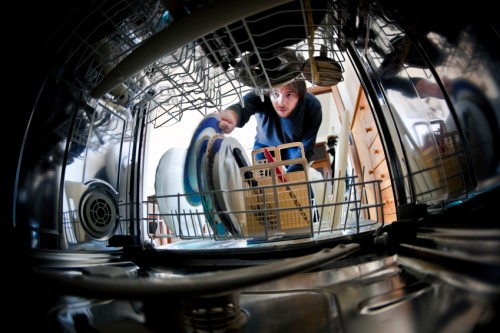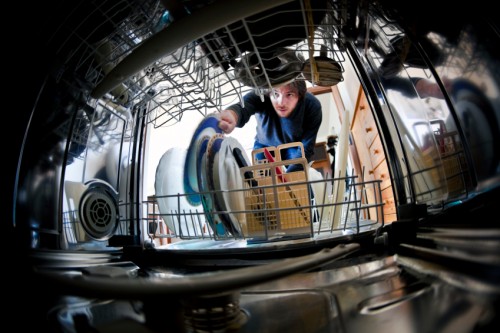Send your question to Umbra!
Q. Dearest Umbra,
While pleased as pie to have a new super-efficient dishwasher, I remain curious as to the chemical composition of the required rinse aid. This dishwasher relies on a hot water rinse and its stainless steel tub to somehow dry the dishes — there is no energy-sucking, plastic-melting heating element to accomplish dryness. However, this dishwasher will not run unless its rinse aid receptacle is filled. While I could probably trick it by filling the rinse aid reservoir with water … that would seem likely to promote unsightly spotting. While I enjoy the energy efficiency and quietude of this dishwasher, I am concerned that I may be slowly killing my family through hydrophobic rinse aid ingestion. What is this stuff anyway?
Spotless But Concerned
Louisville, Colo.
A. Dearest Spotless,
There is an easy answer to this issue, but in researching it I discovered yet another of those depressing unknown household hazards that deflate my sense of humor.
 Rinse charming?Conventional rinse aid is one of the mystery products wherein manufacturers only need disclose active ingredients. We can find Material Safety Data Sheets for these products on line, which say reassuring things such as “The manufacturer’s MSDS does not state whether the ingredients are considered carcinogens or potential carcinogens.” Rumor has it that conventional rinse aids do contain phosphates, the chemical compounds that can lead to marine dead zones. By “rumor,” I mean that the “eco” rinse aids claim a lack of phosphates.
Rinse charming?Conventional rinse aid is one of the mystery products wherein manufacturers only need disclose active ingredients. We can find Material Safety Data Sheets for these products on line, which say reassuring things such as “The manufacturer’s MSDS does not state whether the ingredients are considered carcinogens or potential carcinogens.” Rumor has it that conventional rinse aids do contain phosphates, the chemical compounds that can lead to marine dead zones. By “rumor,” I mean that the “eco” rinse aids claim a lack of phosphates.
All sorts of ecologically preferable companies offer rinse aids in which all ingredients are disclosed. Various promises to love fish and plants and hate landfills are pledged upon the labels. But here is an even better option: reading online (as I often do, don’t you know), I encountered chatty dishwasher-loving people who are using our old friend white vinegar as a rinse aid. I was especially interested in this because where I am currently living the water is hard like a rock, so our glasses (“glassware” I believe is the proper term) come out cloudy like Seattle, and gross and embarrassing to hostliness. Oh my heavens, my life has changed. Put white vinegar in the rinse aid dispenser, or put a cup filled with it upright in the bottom rack when you run the wash. Come on over for a drink — our glassware is no longer embarrassing.
The bad news can be delivered through more good news. The new site GoodGuide seems to be what many of you want and need: decent, in-depth ratings of products. I hope they make millions of dollars. Unfortunately, while I was looking up rinse aids (check out the rankings), I learned that the dishwasher is considered, by some, to be an incredibly toxic appliance. In 1999, researchers at the University of Texas-Austin released data on the ability of dishwashers to “strip” chemicals out of water and release them in air. This is of course why we smell chlorine when we are using a chlorine-based dishwashing detergent. Other, less stinky but also harmful pollutants may be removed from the water and let loose in your home: chlorine from water treatment, radon, chloroform, perhaps other volatile organic compounds.
We’re not going to stop using our very efficient dishwashers, so perhaps this tidbit of information will simply further encourage our use of less-toxic rinse agents (and detergents), and help us remember to run dishwasher loads at night. You see, if we leave the washer door shut for a while after the load finishes, less of the potentially toxic steam will waft out toward us. And of course, it’s best if we run appliances at night anyway, to lessen the business-hours load on the electric grid.
Humorlessly,
Umbra



